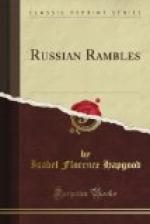Foreigners can also study the bargaining process at its best—or worst —in the purchase of furs. The Neva freezes over, as a rule, about the middle of November, and snow comes to stay, after occasional light flurries in September and October, a little later. Sometimes, however, the river closes as early as the end of September, or as late as within a few days of Christmas. Or the rain, which begins in October, continues at intervals into the month of January. The price of food goes up, frozen provisions for the poorer classes spoil, and more suffering and illness ensue than when the normal Arctic winter prevails. In spite of the cold, one is far more comfortable than in warmer climes. The “stone” houses are built with double walls, three or four feet apart, of brick or rubble covered with mastic. The space between the walls is filled in, and, in the newer buildings, apertures with ventilators near the ceilings take the place of movable panes in the double windows. The space between the windows is filled with a deep layer of sand, in which are set small tubes of salt to keep the glass clear, and a layer of snowy cotton wadding on top makes a warm and appropriate finish. The lower classes like to decorate their wadding with dried grasses, colored paper, and brilliant odds and ends, in a sort of toy-garden arrangement. The cracks of the windows are filled with putty or some other solid composition, over which are pasted broad strips of coarse white linen. The India rubber and other plants which seem so inappropriately placed, in view of the brief and scant winter light, in reality serve two purposes—that of decoration and that of keeping people at a respectful distance from the windows, because the cold and wind pass through the glass in dangerous volume.
Carpets are rare. Inlaid wooden floors, with or without rugs, are the rule. Birch wood is, practically, the exclusive material for heating. Coal from South Russia is too expensive in St. Petersburg; and imported coal is of the lignite order, and far from satisfactory even for use in the open grates, which are often used for beauty and to supplement the stoves.




